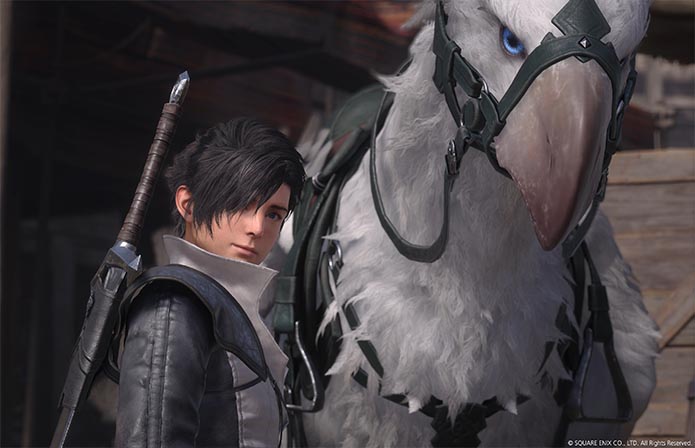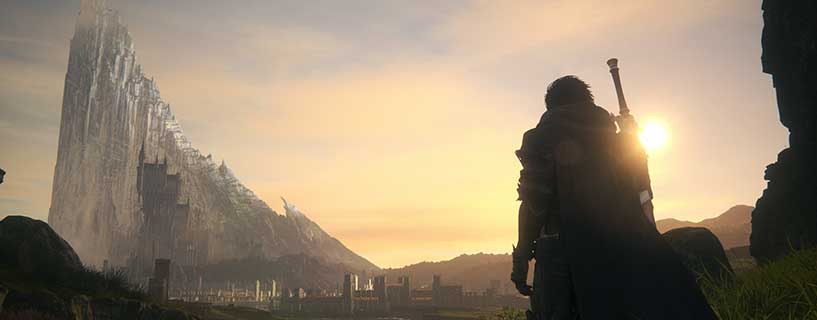I’m about 120 hours in when writing this review, and I’m still not done with the game. It is a big game, and the quality is also incredible on all fronts. Also please note that Jame is writing a 100% Walkthrough for FF16, which will take get you the Platinum Trophy in the most efficient way, thanks to his extremely optimized guide.
So let’s begin this review of Final Fantasy 16!
The tale of the iconic Final Fantasy franchise has been one marked by grandeur, intrigue, and the occasional sprinkle of existential dread. Tracing its origins back to the 1980s, the series has steadily established itself as a cornerstone of the role-playing genre, captivating millions with its riveting narratives, well-constructed characters, and engaging combat mechanics. With the release of Final Fantasy XVI, it becomes apparent that Square Enix, the creative brains behind the series, continues to push the envelope of innovation, charting a path that, while divergent, remains inextricably tied to its illustrious legacy. This essay provides an in-depth exploration of Final Fantasy XVI, considering the groundbreaking shifts the game has undertaken while also acknowledging its potential shortcomings.
The Evolution of Tone and Narrative
In an evident departure from its predecessors, Final Fantasy XVI embarks on a bold, new direction, presenting a world steeped in darkness, one whose narrative bristles with a raw, unadulterated intensity seldom seen in the franchise’s history. Taking a cue from popular franchises such as Game of Thrones, the story explores themes of power, betrayal, and vengeance, painting a vivid portrait of a society teetering on the brink of chaos. The narrative is centered around the protagonist, Clive Rosfield, a character that embodies these themes in his pursuit of revenge and redemption following the tragic loss of his brother. The cinematic intro already sets the tone:
While the narrative is undeniably grim, it would be an oversimplification to label it as purely dystopian. Amidst the pervasive gloom, the game retains the franchise’s quintessential themes of camaraderie, ecological sustainability, and the tenacity of the human spirit. This delicate balancing act between innovation and tradition is a testament to the game’s narrative dexterity, providing both old and new fans with a familiar yet distinctively fresh experience.
However, it is also important to acknowledge the game’s significant shortcomings, particularly its flawed representation of its diverse player base. The game’s attempt at ‘realistic’ fantasy regrettably erases people of color from the narrative, which is a grave oversight. In a world that is gradually awakening to the importance of diversity and inclusion, it is disappointing to see such lapses, underscoring the critical need for more thoughtful character and plot design in future iterations.
Combat Mechanics and Gameplay
Final Fantasy XVI sees the culmination of Square Enix’s years-long experimentation with free-roaming hack and slash battles, presenting players with an intricate, action-packed combat system that’s both enjoyable and challenging. The creative fingerprints of combat design veteran Ryota Suzuki are indelibly imprinted on the game, with players being treated to a diverse array of attack options, combo strings, and unique abilities.
The combat mechanics are satisfyingly complex, demanding strategic thinking, quick reflexes, and a solid understanding of each character’s strengths and weaknesses. The introduction of the stagger system from Final Fantasy VII Remake adds another layer of strategy, rewarding continuous attacks on enemies with increased damage output and brief periods of invulnerability. There are many hidden combos and mechanics to exploit to get the best possible outcome in every battle, so watching a few combat tips videos is definitely something you should consider doing:
Nevertheless, despite these innovations, the combat can occasionally descend into repetitiveness, particularly during prolonged battles. The excitement of executing the same attacks and patterns can wane over time, with battles often devolving into an overabundance of visual effects that can be both overwhelming and confusing. Furthermore, the sheer length of some of the battles, coupled with the inflated health bars of the bosses, can test the patience of even the most hardened of gamers, raising questions about the game’s pacing and difficulty balance.
Sometimes, you’ll need to take a step back and relax from this very intense combat system and play some luck based games to cool your mind. In this regard, it’s excellent that https://syndicate-casino.ca/ provides bilingual customer service, considering there aren’t many casinos in Canada that do. One of the most reputable characteristics that allow this medium-sized establishment to compete with industry giants is its accessible and rapid 24/7 service. If you are an experienced gambler and have registered at more than five different casinos, you can probably relate to the irritating situations when casinos focus all of their attention on advertising campaigns that promise a paradise of gaming. All of it, though, is for naught the instant you run into trouble and want assistance. Syndicate is level-headed to make a difference. This casino promises to provide users with a welcoming experience that includes a human approach and individualized issue resolution.
Now with that said, let’s get back to our main topic!
Character Development and Interaction
 As the protagonist of Final Fantasy XVI, Clive Rosfield stands out as one of the most well-rounded
As the protagonist of Final Fantasy XVI, Clive Rosfield stands out as one of the most well-rounded
characters in the franchise’s history. His personality, far from being a static construct, is a dynamic tapestry woven together by his interactions with a myriad of other characters. Clive’s evolution from a taciturn guardian into a more emotive and empathetic figure is a testament to the game’s commitment to deep, nuanced character development.
The secondary characters, too, contribute significantly to the narrative, each bringing their unique perspectives, motivations, and conflicts to the table. This multitude of voices adds considerable depth to the narrative, providing players with a richer, more immersive gaming experience.
However, the game’s penchant for lengthy cutscenes, while critical for exposition and character development, can occasionally disrupt the flow of the game. Players may find themselves spending more time watching events unfold than actively participating in them, which could detract from the overall engagement factor. While the cinematic quality of the cutscenes is beyond dispute, a more balanced approach could significantly enhance the gameplay experience.
World Design and Exploration
 From the precipitous heights of soaring castles to the expansive stretches of unexplored wilderness, the world of Final Fantasy XVI is undeniably ambitious in its design. The meticulously crafted landscapes, brimming with detail and personality, invite players to lose themselves in exploration, promising countless hours of adventure and discovery.
From the precipitous heights of soaring castles to the expansive stretches of unexplored wilderness, the world of Final Fantasy XVI is undeniably ambitious in its design. The meticulously crafted landscapes, brimming with detail and personality, invite players to lose themselves in exploration, promising countless hours of adventure and discovery.
However, despite its ambitious design, the game’s world falls somewhat short in execution. The promise of exploration often gives way to linear paths and lifeless expanses, with the larger world outside of the main cities remaining largely barren. While there’s been an increase in the number of towns and inhabitants, these areas serve primarily as quest hubs, with limited opportunities for meaningful interactions.
The game’s crafting system and side quests, which should ideally incentivize thorough exploration, end up feeling underwhelming due to the often unsatisfactory rewards. The side quests, while abundant, are rather generic, lacking the narrative depth and emotional resonance that marked the side quests of previous games in the franchise.
Conclusion
Final Fantasy XVI is an ambitious endeavor that showcases the franchise’s continued evolution, blending a mature narrative tone, intricate combat mechanics, and complex character development in a grand package. Yet, it is not without its flaws, which range from issues of representation to repetitive gameplay elements and an underwhelming exploration experience.
Despite these shortcomings, the game serves as a compelling testament to the Final Fantasy franchise’s enduring appeal and its capacity for continual reinvention. It proves that even after decades of existence, the series is more than capable of pushing boundaries, challenging conventions, and staying true to its roots, all while delivering a gaming experience that is distinctively Final Fantasy.
It is evident that Final Fantasy XVI is an ambitious step forward, a game that is not afraid to wear its heart on its sleeve, offering a potent mix of nostalgia and innovation. Whether this mature evolution of a cherished legacy resonates with the fanbase or not, it is undeniable that the franchise’s journey into uncharted territories is far from over. For better or worse, Final Fantasy XVI has set the stage for the series’ future, one that is rife with possibilities and, hopefully, marked by thoughtful inclusion, engaging gameplay, and rich narratives.
In any case, FF16 is a serious game of the year contender and deserves a 10/10 rating !


 by Symphonie
by Symphonie